
DOWNLOAD
DATE
Contact
With the onset of new technologies such as 5G, NFV and IoT, telecom executives are increasingly realizing that transformation of technology organization is imminent. The CTO office is at the center of this and needs to rethink its strategic roadmap and operating model. In this paper, we assess how a gradual transformation from traditional IT/network units to a more functional organization will address several of the legacy constraints in adopting new technologies. The effective implementation of such a project shall result in reduced costs and organizational redundancies, and provide further push to digitalization initiatives.
Telcos are facing pressure for change
Globally, telecom operators are looking to improve customer experience, lower production costs, and increase innovation pace and time to market. They are striving to adapt their approaches in order to deliver these objectives sustainably. However, as pointed out in our last report, “Major strategic choices ahead of telcos”, operators are struggling with the increasing gamut of strategic and technical options. They often lack clarity in decision-making. Technology is changing at a rate faster than what organizations can comprehend at times, and operators’ structure will need to adapt to this in the coming years. Operators need to assess whether their technology functions are prepared and able to capture new opportunities in productive ways that reflect their strategic requirements. This requires re-examining the core operating model from a technology point of view, which consists of organization structure, processes, governance, tools, etc.
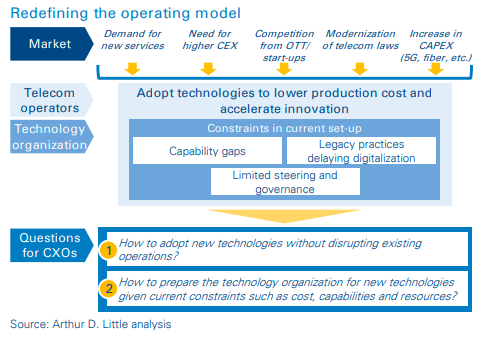
Lack of preparation is leading to uncertainty
Lack of preparation for making choices is leading to significant uncertainties among operators. Through our recent projects, we have identified and addressed the top three organization-level challenges CTOs need to address:
- Capability gaps
- Limited steering & governance
- Legacy practices delaying digitalization
If not addressed properly, these can lead to redundant capabilities, parallel technology stacks, and inefficiencies. These will result in prolonged time to market for new services.
Capability gaps
New technologies emerging under the umbrella of 5G, the Internet of Things (IoT), network functional virtualization (NFV), etc., and new methodologies such as agile and DevOps (and its various derivatives, e.g., SecOps, ChatOps and Rugged DevOps), require new capabilities for development. Operators often face dilemmas in how to leverage existing capabilities across traditional network and IT organizations effectively, especially when most solutions are virtualized. In addition, there is a pressing need to develop new skill sets altogether. These require hiring and training employees, as well as fusing the knowledge that sits in traditional network and IT organizations.
Limited steering and governance
Even with well-thought-out transformations, organizations face new issues as they move along this journey. Centralized functions should be responsible for creating technology roadmaps, providing strategic direction, and controlling and governing the entire technology division. For many operators, these are either are missing or ineffective. As a result, they end up developing redundant resources, processes and assets. We have seen operators building parallel cloud stacks, procuring redundant software licenses, and using different applications for the same purpose by different teams. They often struggle to define end-to-end ownership of new technology deployments and operations. Unclear accountabilities lead to delayed or even stand-still decision-making, delayed and costly adoption of new technologies, and duplication of efforts by multiple teams in the same organization.
Legacy practices delaying digitalization
Digitalization presents growth opportunities for telcos in the next decade. In our paper “Delivering the digital dividend”, we estimated that an aggressive move into digitalization could improve EBIT margin by 10 percentage points within 10 years. However, most operators are unable to take full advantage of this opportunity. Legacy systems, lack of efficient processes and, very often, inability to understand the scope and requirements of digitalization, are delaying telcos’ ambitions. These old practices inhibit creation of a new class of services (for example, B2B2X opportunities), which are necessary for growth. For this segment, telcos need to gain better understanding of the industries in which their customers operate. However, led by traditional delivery models, technology teams are still sitting far from their BUs, and often lack the agility and openness required in these processes.
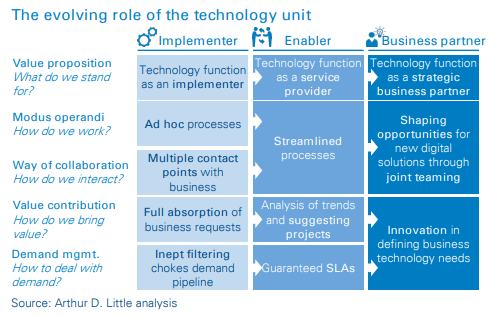
Re-lay the brick road to success
Network and IT are two long-standing pillars of the technology organizations of telecom operators, and organization structures are mostly designed around these two differentiated technology capabilities. As networks are increasingly virtualized, their design and development activities start to resemble application development within the IT organization, even though the skills and competencies required continue to differ to some extent. IT applications and NFV developers will work on the same cloud infrastructure – public or private – developing services and capabilities for mutual consumption. This is a near-term scenario. In the long term, as products and services combine further with consumption of network and application layers, the product development cycle will need to find a significantly integrated approach. (It will need to consider smart service products that require significant integration between the network functions exposed through a virtualized network service layer). As a result, operators need to change their approaches to organization design in order to address these converging functional requirements – albeit by adopting phased approaches instead of fundamental restructuring.
We see the technology organizations of telcos transitioning (See figure on front page) from the current (and often independent) structure of network and IT verticals (Phase 1) to infrastructure and application layers (Phase 2). This will possibly be followed by highly integrated technology organizations (Phase 3).
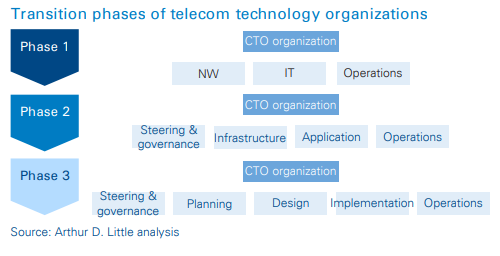
Creating a more integrated organization also requires more fundamental restructuring of conventional capacity and capabilities. Companies must move from the traditional vertically split model of network and IT to organizing technology assets and processes horizontally across applications and infrastructure. This reorganization will focus on four key enablers:
1. Centralize data centers and cloud infrastructure
Currently, IT mostly constitutes server and storage requests in data centers. However, significant demand is expected to emerge from the network function with NFV deployments. As the capabilities required to manage the underlying hardware and virtualization layers are similar, unifying the data center and cloud services for network and IT is a logical move. It also ensures that there is only one entity accountable for delivering centralized services, and operators can realize significant cost savings through better sourcing, efficient asset utilization, and resource/ managed service provider (MSP) consolidation. (Manpower reduction of approximately 30 percent can be realized by avoiding a duplicate cloud organization). Unifying the data center also ensures consolidated development of capabilities within an organization, while making it easier to manage standardized development, implementation and maintenance functions. Hence, application developers and NFV programmers can expect faster time to provisioning and resilient data center operations.
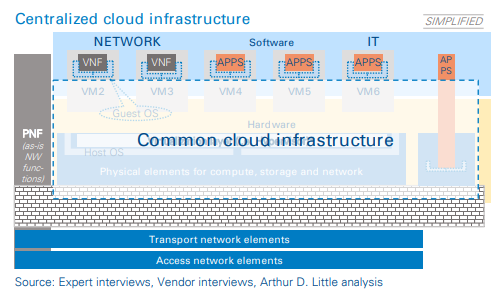
2. Functionally integrate technology capabilities
NFV technologies require traditional network organizations to re-think their operating models across planning, design, implementation and operation. Traditional network organizational units need to expand their scope and capabilities to include virtual network functions (VNFs), in addition to current physical network functions (PNFs). This means network engineers must upgrade their technical skills to ensure smooth transition from PNFs to VNFs.
Network organization requires introducing a range of new roles: VNF package testing, vertical integration of the stack, horizontal integration across the stack, and development and operations of management and orchestration systems. Examples of these include virtual network functions managers (VNFMs), virtualized instruction managers (VIMs) and network functions virtualization orchestrators (NFVOs). New capabilities will also include deployment of automation, superior network data analytics, and security provisioning across the cloud to ensure it is ready for production.
Telcos will need to carefully assess their existing capabilities against the new capabilities they will need, to optimize resources and avoid any duplication. This is because the PNFs will be gradually transitioned to VNFs over next few years. VNF development and maintenance require capability development across both network and IT.
3. Enhance the efficiency and productivity of IT
Telcos are intensifying their efforts to build up digital capabilities within their organizations. Mastering “digital” adds new scope to the IT organization, in that it will have to digitalize customer touchpoints, automate internal processes, simplify core IT architecture, and build platforms to leverage B2B2X opportunities. In many organizations, these activities are allocated to the current teams or units on an ad hoc basis and are not part of their regular job descriptions. However, going forward, technology divisions must have special digital focus if they are to implement the required digital strategies.
Telecom IT organizations aspire to evolve into true strategic business partners in the digital age. This requires them to consult business and develop new solutions at much faster rates than before. The new approaches of working in agile and DevOps frameworks offer significant efficiency, quality and speed benefits (up to 40 percent time to market) but require major culture change. At the same time, many core applications still need to be developed in the traditional waterfall approach to ensure stability and resilience. Telco IT, therefore, needs to accommodate “stability and resilience” and “speed and flexibility” to benefit the most from these emerging ways of working. We have observed several generic approaches that vary in levels of agility, as well as in depth of problem resolution. IT organizations need to assess their as-is capabilities and adopt the most suitable delivery models. In organizations with emphasis on continuity, efficiency, and cost optimization, traditional IT approaches dominate. These organizations are characterized by compliance rules and other regulatory guidelines. On the other side, organizations for which innovation, flexibility, and shorter time to market are key requirements, large percentages of application development are done following agile methodology. There is also the issue of (corporate) culture. After all, many companies need to adapt not only processes, but also the ways of thinking in their workforces. Successful companies such as Amazon, Google, Facebook, and LinkedIn have, however, mastered the art of agility and rigidity at the same time. They are great examples for telcos to learn from, because bimodal approaches, if not managed properly, can sometimes lead to siloed processes, teams and technologies.
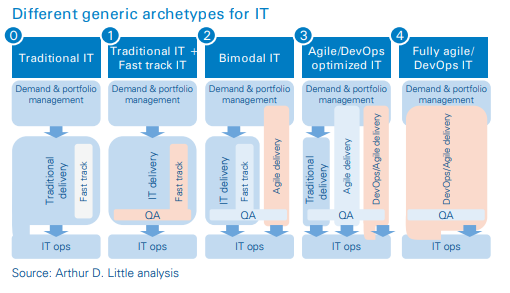
4. Create a central steering function
Telcos must establish centralized steering functions to set the strategic objectives and governance structures for their entire technology organizations. These steering functions should provide both long-term and short-term strategic direction for all technology divisions. They will set and ensure adherence to principles, standards and best technology practices; establish clear boundaries; and resolve any conflicts in terms of accountability. Effective establishment of such functions helps reduce CAPEX, optimize OPEX, improve strategic decisionmaking, shorten time to market, facilitate change, and generate innovation.
Conclusion
We expect new technologies to drive a fundamental shift in telcos’ production and delivery models. They should carefully assess how prepared their technology organizations are in terms of strategy, capabilities, governance and processes.
Based on extensive experience designing and running largescale transformation programs for technology organizations in telcos across the world, we believe centralized data centers and cloud infrastructure are the core of emerging technologies. A range of new functions need to be introduced to accommodate virtualization of network infrastructure. With increasing convergence between network and IT units, a central steering function is essential to foster faster decision-making. Dedicated focus is required to achieve digitization ambitions, and as-is IT processes need to be revamped to accommodate changing customer and business demands. Several options exist in terms of organizing centralized cloud infrastructure and introducing new functions, capabilities, steering functions and digital units, and telcos must adopt the models most suitable for their contexts.
From our experience of leading successful transformations, our proposed phased approach to reorganization benefits telecom operators across multiple areas, including:
- Dedicated focus on application development through an application unit, which eliminates the hassles of infrastructure management.
- Standardized and consolidated common infrastructure layer.
- Higher economies of scale and lower costs.
- Synchronized and optimized operations and maintenance without service interruption
- Service development on top of third-party infrastructure.






